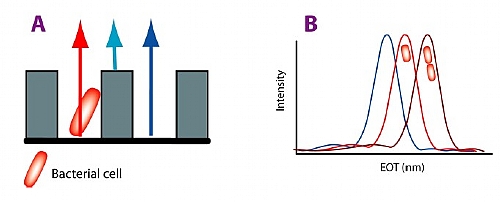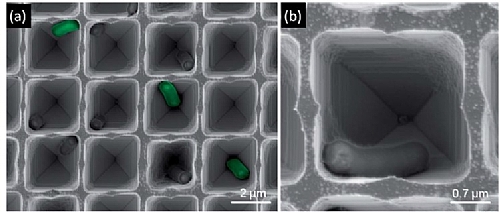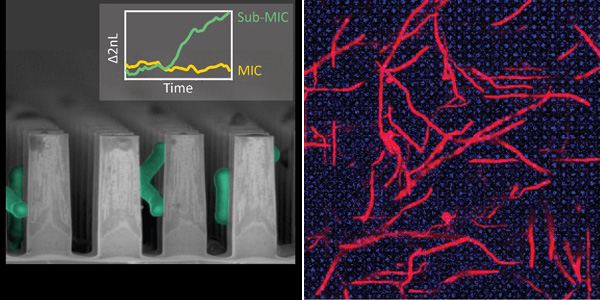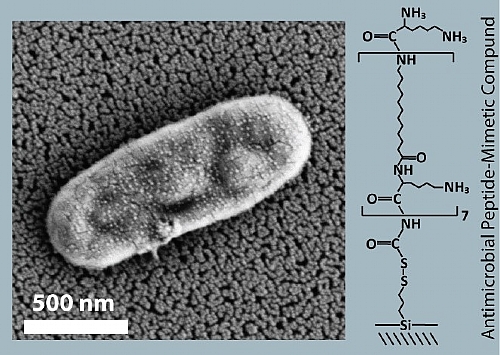The task of rapid detection and identification of bacteria remains a major challenge in both medicine and industry. As current bacteria detection methods rely on lengthy laboratory-based techniques, there is an urgent need for developing biosensing platforms that will allow for rapid detection at point-of-care settings. Our lab designs different optical biosensors that can detect and quantify bacteria in real-time.
Porous Si photonic crystals for rapid bacteria detection:
The sensor is based on a two-dimensional periodic structure of porous Si photonic crystals, developed in collaboration with Prof. Sa’ar from the Hebrew University, in which the pore size is adjusted to fit the target bacteria cells. Bacteria capture within the pores using different surface functionalities measurable induces changes in the zero-order reflectivity spectrum collected from the periodic structure, as shown below.

Bacterial cells presence within the pores (A) affects the refractive index of the porous layer as function of the relative volume they occupy. The bacteria fraction in the pores is monitored in real time by collecting the effective optical thickness (EOT); (B) as this property is determined by the bacteria contribution to the refractive index, n.
Confocal laser microscopy and electron microscopy confirm that the target bacteria cells are individually imprisoned within the porous array. A simple model is suggested to correlate the optical readout and the bacteria concentration and its predictions are found to be in good agreement with experimental results.
In addition, we demonstrate that sensing scheme can be easily modified to potentially allow monitoring of concentration, growth and physiological state of bacteria cells. This generic platform can be tailored to target different microorganisms by tuning the array periodicity and its surface chemistry for rapid and label-free detection outside the laboratory environment.

High-resolution scanning electron micrographs of the biosensor, demonstrating bacteria cells confined within the pores. Some of the bacteria cells are false-colored to ease observation.
Selected Publications:
- Massad-Ivanir N., Mirsky Y., Nahor A., Eitan Edrei, Bonanno-Young L.M, Ben Dov N., Sa’ar A., Segal E., Trap and Track: Designing Self-Reporting Porous Si Photonic Crystals for Rapid Bacteria Detection, Analyst, 139, 3885-3894 (2014).
- Mirsky Y., Nahor A., Edrei E., Massad-Ivanir N., Bonanno L.M., Segal E., Sa’ar A., Optical Biosensing of Bacteria and Cells using Porous Silicon-based Photonic Lamellar Gratings, Appl. Phys. Lett., 103 (3), 033702-033704 (2013).
Silicon diffraction gratings for monitoring bacterial responses and rapid antibiotic susceptibility testing
We have developed label-free biosensors based on two-dimensional photonic crystals of periodic micron-sized pores and pillars. The spacing between the structures allows for bacteria capture, inducing measurable changes in the zero-order reflectivity spectrum collected from the periodic structures.
The optical signal allows for real-time readouts of bacterial responses and activity, such as growth and death. Thus, in collaboration with Bnai Zion Medical Center, we have recently demonstrated that these sensors can be used as a platform for rapid antibiotic susceptibility testing in order to determine the most effective antibiotic for an infection. While in the clinic this test takes more than 8 hours, in our platform, the assay takes 2 hours to perform, encouraging the correct prescription of antibiotics to ill patients in a timely manner.

An electron micrograph of bacterial cells colonized on silicon micropillar arrays (left) and a confocal scanning laser microscopy image (right) of antibiotic-induced filamentous E. coli cells (red) growing on top of the micropillars (blue).
Publications:
- Leonard H., Colodner R., Halachmi S., Segal E., Recent Advances in the Race to Design a Rapid Diagnostic Test for Antimicrobial Resistance, ACS Sensors, 3(11), 2202-2217 (2018).
- Leonard H., Halachmi S., Ben-Dov N., Nativ O., Segal E., Antimicrobial Susceptibility of Bacterial Networks on Micropillar Architectures Using Intrinsic Phase-Shift Spectroscopy, ACS Nano, 11, 6167-6177 (2017).
Nanostructured porous Si for bacteria detection:
Nanostructured porous silicon (PSi) Fabry–Pérot thin films are used as the optical transducer element to monitor changes in the reflectivity spectrum upon target bacteria binding. We have established the feasibility of antibody-conjugated oxidized PSi for optical detection of bacteria via the ‘direct-cell-capture’ approach (Massad-Ivanir et al., 2010, 2011).
Exposure of these biosensors to the target bacteria results in their capture onto the porous surface, inducing predictable changes in the thin-film optical interference spectrum of the nanostructure, i.e., a decrease in the intensity of the reflected light, allowing for rapid detection of low bacterial concentrations.
Recently, we used a novel peptidemimetic compound, as the recognition element (Tenenbaum, 2015). The sequence K-[C12K]7 (referred to as K-7α12, shown below), which is a synthetic antimicrobial peptide is tethered to the porous nanostructure. The K-7α12 compound is a member of a family of oligomers of acylated lysines (OAKs), mimicking the hydrophobicity and charge of natural antimicrobial peptides.
Changes in the reflectivity spectrum of the biosensor are monitored upon exposure to different bacteria and their lysate suspensions. We show that capture of bacterial cell fragments induce changes in the reflectivity spectrum, proportional to the E. coli concentration, thereby enabling rapid, sensitive and reproducible detection of E. coli at concentrations as low as 103 cells per mL.

High-resolution scanning electron micrographs of the OAK-modified biosensor after incubation with E. coli bacterial lysate suspension, showing an intact cell captured onto the nanostructure.
Selected Publications:
- Massad-Ivanir N., Shtenberg G., Raz N., Gazenbeek C., Budding D., Bos M.P, Segal E., Porous Silicon-Based Biosensors: Towards Real-Time Optical Detection of Target Bacteria in the Food Industry, Scientific Reports, 6, Article number: 38099 (2016).
- K Urmann, S Arshavsky-Graham, JG Walter, T Scheper, E Segal., Whole-cell detection of live lactobacillus acidophilus on aptamer-decorated porous silicon biosensors, Analyst 141 (18), 5432-5440 (2016).
- Tenenbaum E. and Segal E., Optical Biosensors for Bacteria Detection by a Peptidomimetic Antimicrobial Compound, Analyst, 140, 7726-7733 (2015).
- Massad-Ivanir N., Shtenberg G., Segal E., Biosensors for Bacteria Detection, Journal of Visualized Experiments. (81), e50805, doi:10.3791/50805 (2013).
- Massad N., Shtenberg G., Tzur A., Krepker M., Segal E., Engineering Nanostructured Porous SiO2 Surfaces for Bacteria Detection via “Direct-Cell-Capture”, Anal. Chem., 83, 3282–3289 (2011).
- Massad N., Shtenberg G., Zeidman T., Segal E., Construction and Characterization of Porous SiO2/Hydrogel Hybrids as Optical Biosensors for Rapid Detection of Bacteria, Adv. Funct. Mater., 20, 2269-2277 (2010).
Researchers: Talya Borkom and Dr. Naama Massad-Ivanir


